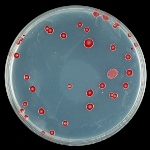You are here:
Campylobacter

Spread and clinical picture
In the Federal Republic of Germany and in other European countries Campylobacter is by now the most frequent bacterial pathogen for intestinal infections. The infectious disease caused in humans by the germ is called campylobacteriosis and mainly involves diarrhoea. Although these acute symptoms are in most cases self-limiting, there are in rare cases late sequelae such as arthritis and the so-called Guillen-Barré syndrome, an auto-immune disease of the peripheral nervous system, which may lead to symptoms of paralysis.
Main sources of infection
Campylobacteriosis is mainly caused by thermotolerant C. jejuni, C. coli and to a lesser extent C. lari and C. upsaliensis. In most cases they are transmitted to humans as faecal contamination of infected animals via foods. Campylobacters cannot multiply on foods because of their exacting growth conditions but they have a relatively high ability to survive there. A main source of infection is insufficiently heated or contaminated poultry meat; an infection can be caused in particular in the event of poor kitchen hygiene by cross contamination. Further possible sources of infection are raw milk, raw pork or beef meat, untreated drinking water, contaminated water in bathing lakes as well as contact with infected domestic animals.
Characteristics
The genuses Campylobacter, Arcobacter and Sulfurospirillum constitute the family of Campylobacteraceae within the order of Campylobacterales, which in turn can be allocated to episolon proteobacteria.
Campylobacters are mobile gram- negative as a rule spirally bent rods which have a width of 0.2 to 0.8 µm and a length of 0.5 to 5 µm. Campylobacters grow under microaerobic conditions (increased CO2 demand and higher O2 sensitivity). If the bacteria are exposed to unfavourable environmental conditions (such as cold, acid, increased osmolarity, oxygen or nutrient limitation), the rods are transformed into cocci which present all physiological characteristics of living cells but can no longer be cultivated under laboratory conditions.
The reservoir of Campylobacter includes warm-blooded wild, domestic animals and pets (birds and mammals) without the latter showing clinical symptoms of a disease.
Opinion
(1)| Date | Title | Size |
|---|---|---|
|
13.04.2016 BfR Opinion No 008/2016
|
Raw milk: boiling protects against infection with Campylobacter |
40.4 KB
|
Press releases
(1)| Date | Title | Keywords |
|---|---|---|
|
17.12.2021 50/2021
|
For that fondue meat doesn't make you sick | campylobacter, food infection , zoonoses |
